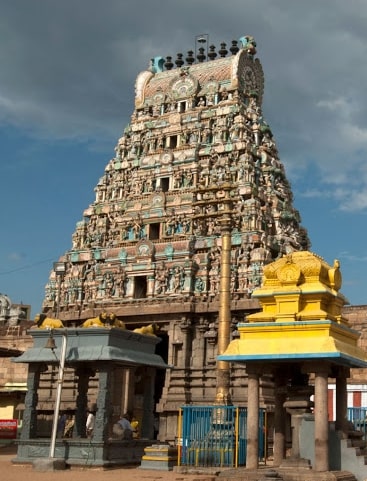Thiruvottiyur Sri Aadhipureeswarar Temple, Chennai

Address
Thiruvottiyur Sri Aadhipureeswarar Temple, Thiruvottriyur Chennai PIN 600019
Diety
Thiyagaraja Swamy, Aadhipureeswarar, and Thiruvottrieswarar Amman: Vadivudaiamman, Thiripurasundari
Introduction
Thyagaraja Temple (also called as Vadivudai Amman Temple) is a Hindu temple dedicated to Hindu god Shiva. It is located in Tiruvottiyur in the northern part of Chennai, Tamil Nadu, India. The temple is revered by the Tevaram hymns of Saiva nayanars, the 7th century Tamil saint poets and classified as Paadal Petra Sthalam. All the Three of Thevaram Moovar (Appar, Samandar and Sundarar) has rendered Thevaram songs in this temple. The temple is closely associated with the saint poet Sundarar and Pattinathar. The temple has been in vogue from the Pallava times of the 7th century and widely expanded by Chola kings during the 11th century. The temple has a seven tiered gateway tower, a tank, with the overall temple area covering 1 acre. The temple is administered by the Hindu Religious and Endowment Board of the Government of Tamil Nadu. The temple draws parallel with the Thygaraja temple in Tiruvarur as both the temples were expanded by Rajendra Chola I and both have the same dance poses of Shiva. The temple is one of the 51 Sakthi Peetams in the country.
Puranic Significance
There are a number of inscriptions inside the temple dating back to Pallava period. Sankaracharya, the 8th century scholar in the advaita school of Hinduism is believed to have visited the temple to put down the power of evil. The temple was originally built by Pallavas and later rebuilt by Rajendra Chola I Brahmā is the Hindu god of creation and one of the three primary gods of Hinduism, the other two being Viṣņu and Śiva. He created the Gods and demons – both these groups fight against each other. While the demons, called asuras use muscle power, the Gods called devas use the power of Veda, the sacred texts. Once, two demons, Madhu and Kaithaba tricked the gods to steal the Veda, chopped it to pieces and hid it in the bottom of the sea. Vishnu fought the demons, but could not defeat them.He prayed to Shiva and Parvathi and with the accomplishment, he was able to defeat the demons. He took the form of Matsya, a fish to search the Veda. The recovered Veda from the bottom of the sea was brought to the deity at this temple, who reunited and purified it. The wishing tree of gods, makizha tree, became the sacred tree of the temple.
Special Features
The presiding deity is Aadhipureeswarar is in the form of a mud mound. overed by armour. On the day of the full moon of the Tamil month karthigai, the armour is removed and the representation of the god is visible to devotees. The Lord is anointed with punugu, javvadhu, and sampirani oils. There is a Durga shrine in the northern side of the temple. Inside the main temple complex, opposite the main shrine, is Nataraja shrine and in the koshta is the Ganapati shrine. The Ganapati is known as Gunalaya Ganapati (abode of bliss) and there is also the idol of Adi Shankara, just behind the main shrine inside the complex. There are also deities like Subrahmanya installed there. The Dakshinamurthy statue is in the northern Koshta facing south there is also the subcomplex shrine of Kali. Adi Shankara is said to have installed a chakra to calm down the Devi and to make her Sowmya roopi (calm and resplendent). To this day, a select group of Nampoothiri families perform the pooja and aradhana to this Lord and Goddess as desired by Adi Shankara. The name of the goddess at this temple is Vadivudaiamman alias Tripurasundari. The goddess is housed in a separate shrine inside the Temple complex. This temple is one of the Three Sakthi Temples in the region. Thiruvudai Amman, Melur is known as Ichchaa Sakthi (the one who fulfills wishes); Vadivudai Amman, Tiruvottiyur is known as Gnaana Sakthi (the one who blesses with Gnaanam) and the Kodiyidai Amman Temple, Thirumullaivoyal as Kriyaa Sakthi (the one who assists us in all our actions).Other deities in the temple include Agasalingam, Thiruvotrieswarar, Thiruputheeswarar (between Vattaparaiman and Durga shrines), Kuzhandhai Eesar, Kalyana Sundarar, Jaganadhar, Annamalayar, Ramanathar, Suryan, Chandran, Nalvars, Jambukeswarar, Nagalingar, Meenakshi, Sundareswarar, Sahasralingam, Amirthakandeesar, Gowlieeswarar, and Ekapaadhar, Gunalaya Vinayagar, Aruljothi Murugan, Valar Kali. The twenty seven stars of Tamil calendar are believed to have worshipped Shiva in this temple. The inscription park at the temple has about 20 inscriptions from the time of the Chola kings installed.
Festivals
The prime festival is performed in the Tamil month of Masi (February–March) and historically draws large crowd. On the eighth day, an additional function called Mahiladisevai is performed.The Durgadevi shrine in the northern side of the temple is associated with Kannagi, the protagonist of Silappadikaram, a 2nd-century Tamil epic.Each year a 15-day festival is celebrated in honour of Durga Devi and on the last day, the thatch roof of the event is burnt to symbolize Kannagi burning Madurai at the end of the epic.
Century/Period/Age
1000-2000 years old
Managed By
Hindu Religious and Charitable Endowments (HRCE)
Nearest Bus Station
Thiruvottriyur
Nearest Railway Station
Thiruvottriyur
Nearest Airport
Chennai






